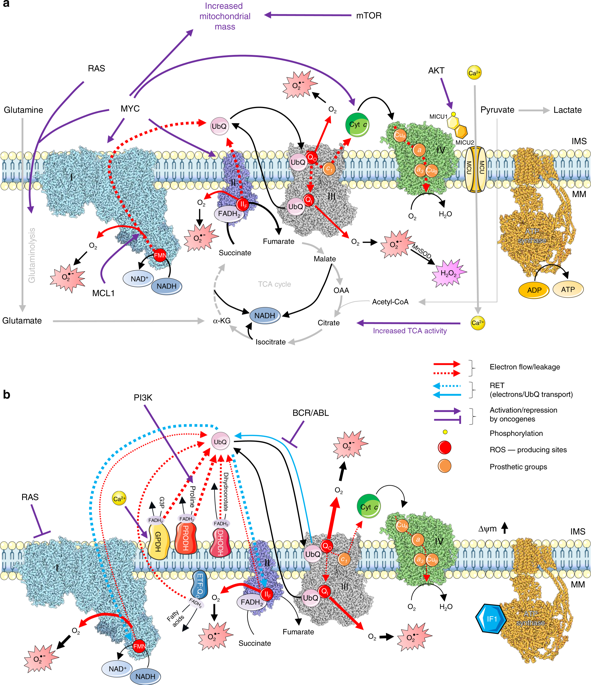当前位置:
X-MOL 学术
›
Br. J. Cancer
›
论文详情
Our official English website, www.x-mol.net, welcomes your
feedback! (Note: you will need to create a separate account there.)
Oncogenic pathways and the electron transport chain: a dangeROS liaison.
British Journal of Cancer ( IF 6.4 ) Pub Date : 2019-12-10 , DOI: 10.1038/s41416-019-0651-y Vittoria Raimondi 1 , Francesco Ciccarese 1 , Vincenzo Ciminale 1, 2
British Journal of Cancer ( IF 6.4 ) Pub Date : 2019-12-10 , DOI: 10.1038/s41416-019-0651-y Vittoria Raimondi 1 , Francesco Ciccarese 1 , Vincenzo Ciminale 1, 2
Affiliation

|
Driver mutations in oncogenic pathways, rewiring of cellular metabolism and altered ROS homoeostasis are intimately connected hallmarks of cancer. Electrons derived from different metabolic processes are channelled into the mitochondrial electron transport chain (ETC) to fuel the oxidative phosphorylation process. Electrons leaking from the ETC can prematurely react with oxygen, resulting in the generation of reactive oxygen species (ROS). Several signalling pathways are affected by ROS, which act as second messengers controlling cell proliferation and survival. On the other hand, oncogenic pathways hijack the ETC, enhancing its ROS-producing capacity by increasing electron flow or by impinging on the structure and organisation of the ETC. In this review, we focus on the ETC as a source of ROS and its modulation by oncogenic pathways, which generates a vicious cycle that resets ROS levels to a higher homoeostatic set point, sustaining the cancer cell phenotype.
中文翻译:

致癌途径和电子传递链:一个危险的ROS联络。
致癌途径中的驱动突变、细胞代谢的重新布线和改变的 ROS 稳态是癌症密切相关的标志。来自不同代谢过程的电子被引导到线粒体电子传递链 (ETC) 中,为氧化磷酸化过程提供燃料。从 ETC 泄漏的电子会过早地与氧气发生反应,导致产生活性氧 (ROS)。几种信号通路受 ROS 影响,ROS 充当控制细胞增殖和存活的第二信使。另一方面,致癌途径劫持 ETC,通过增加电子流或影响 ETC 的结构和组织来增强其产生 ROS 的能力。在这篇综述中,我们关注 ETC 作为 ROS 的来源及其通过致癌途径的调节,
更新日期:2019-12-11
中文翻译:

致癌途径和电子传递链:一个危险的ROS联络。
致癌途径中的驱动突变、细胞代谢的重新布线和改变的 ROS 稳态是癌症密切相关的标志。来自不同代谢过程的电子被引导到线粒体电子传递链 (ETC) 中,为氧化磷酸化过程提供燃料。从 ETC 泄漏的电子会过早地与氧气发生反应,导致产生活性氧 (ROS)。几种信号通路受 ROS 影响,ROS 充当控制细胞增殖和存活的第二信使。另一方面,致癌途径劫持 ETC,通过增加电子流或影响 ETC 的结构和组织来增强其产生 ROS 的能力。在这篇综述中,我们关注 ETC 作为 ROS 的来源及其通过致癌途径的调节,











































 京公网安备 11010802027423号
京公网安备 11010802027423号